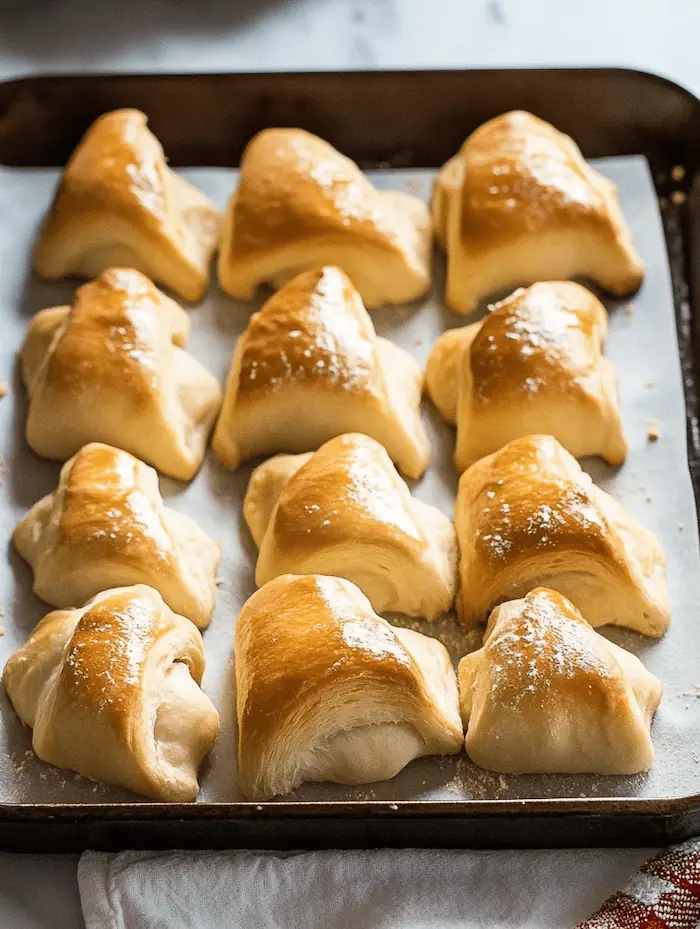Gluten-free crescent rolls are here to save the day, offering the same indulgent taste and texture while accommodating your dietary needs. Whether you’re hosting a holiday dinner or simply craving a comforting treat, this guide will teach you everything you need to know to make and enjoy gluten-free crescent rolls from scratch.
But why are gluten-free crescent rolls such a big deal? For many, it’s more than a lifestyle choice; it’s a necessity. Gluten, a protein found in wheat, barley, and rye, can wreak havoc on the health of those with celiac disease or gluten intolerance. Even for those without sensitivities, reducing gluten intake has been linked to improved digestion and energy levels.
In this comprehensive guide, we’ll explore the ins and outs of gluten-free crescent rolls—from understanding their ingredients to perfecting your baking technique. We’ll also share tips for overcoming common challenges and ideas for serving and storing your delicious creations. So, let’s roll up our sleeves and dive into the wonderful world of gluten-free baking!
Table of contents
- Why Choose Gluten-Free Crescent Rolls?
- Ingredients for Gluten-Free Crescent Rolls
- Step-by-Step Recipe for Gluten-Free Crescent Rolls
- Common Challenges and How to Overcome Them
- Serving Suggestions for Gluten-Free Crescent Rolls
- Storing and Reheating Gluten-Free Crescent Rolls
- Frequently Asked Questions (FAQs)
- Health Benefits of Gluten-Free Crescent Rolls
- Exploring Ready-Made Gluten-Free Crescent Rolls
- Conclusion
Why Choose Gluten-Free Crescent Rolls?
For many people, the idea of “gluten-free” often conjures concerns about taste, texture, or difficulty in preparation. But modern gluten-free baking has come a long way, offering solutions that rival traditional recipes in flavor and quality.
Nutritional Benefits
Gluten-free crescent rolls often incorporate nutrient-dense flour alternatives like almond, rice, or chickpea flour, which can add vitamins, minerals, and protein to your diet. Compared to traditional crescent rolls, they may also be lower in carbohydrates and calories depending on the recipe.
Who Needs Gluten-Free Crescent Rolls?
If you fall into any of these categories, gluten-free crescent rolls are a perfect fit:
- Celiac Disease: For those with celiac disease, even a small amount of gluten can cause severe digestive and immune reactions.
- Gluten Sensitivity: Some individuals experience bloating, headaches, or fatigue after consuming gluten, even without a formal diagnosis.
- Lifestyle Choice: Many people adopt gluten-free diets for overall health benefits or to explore diverse culinary options.
Ingredients for Gluten-Free Crescent Rolls
Creating gluten-free crescent rolls starts with the right ingredients. Unlike traditional baking, gluten-free recipes rely on specific substitutions to achieve the desired texture and taste. Here’s what you’ll need:
Core Ingredients
- Gluten-Free Flour Blend:
- A high-quality gluten-free flour blend is essential. Look for one that includes xanthan gum or guar gum, as these are critical for mimicking the elasticity of gluten. Popular blends often contain rice flour, potato starch, and tapioca flour.
- Xanthan Gum (if not included in your flour blend):
- This binding agent holds the dough together, ensuring the crescent rolls don’t crumble.
- Active Dry Yeast:
- Yeast is crucial for the dough’s rise, giving it a soft and fluffy texture.
- Milk (or non-dairy alternative):
- Warm milk helps activate the yeast and contributes to a richer flavor. Almond milk or oat milk works well for dairy-free versions.
- Butter (or non-dairy butter):
- Adds that signature buttery taste. Use a vegan alternative for dairy-free rolls.
- Eggs:
- Eggs provide structure and moisture. For egg-free options, you can use flaxseed or chia seed gel.
- Sugar:
- A small amount of sugar feeds the yeast and balances the flavor.
- Salt:
- Enhances the overall taste and prevents the dough from being too bland.
Optional Additions
- Herbs and Spices: Add rosemary, garlic powder, or paprika for savory rolls.
- Cheese: Incorporate shredded cheese into the dough or as a topping for extra richness.
- Sweet Fillings: Use cinnamon and sugar or a dollop of jam to turn these into a sweet treat.

Step-by-Step Recipe for Gluten-Free Crescent Rolls
1. Preparing the Dough
- Activate the Yeast:
- Warm 1 cup of milk (not too hot, around 100°F/38°C) and dissolve 1 tablespoon of sugar in it. Add 1 packet (2 1/4 tsp) of active dry yeast and let it sit for 5–10 minutes until frothy.
- Combine Dry Ingredients:
- In a large mixing bowl, whisk together 3 cups of gluten-free flour, 1 teaspoon of xanthan gum (if not pre-mixed in your flour), and 1 teaspoon of salt.
- Mix Wet Ingredients:
- Beat 2 large eggs in a separate bowl. Add the activated yeast mixture and 1/4 cup of melted butter. Mix thoroughly.
- Form the Dough:
- Slowly add the wet ingredients to the dry mixture. Stir until a sticky dough forms. If the dough feels too wet, add 1 tablespoon of flour at a time until manageable.
2. Shaping the Crescent Rolls
- Roll Out the Dough:
- Lightly flour a clean surface and roll the dough into a circle about 1/4 inch thick.
- Cut the Dough:
- Use a pizza cutter to slice the dough into triangles, just like slicing a pizza. Aim for 8–12 triangles, depending on your preferred roll size.
- Shape the Crescents:
- Starting at the wide end of each triangle, roll it tightly towards the point. Curve the edges slightly to form the crescent shape.
3. Baking Tips
- Preheat the Oven:
- Heat your oven to 375°F (190°C). Line a baking sheet with parchment paper.
- Proof the Rolls:
- Place the shaped rolls on the baking sheet, cover with a damp cloth, and let them rise in a warm place for 30–45 minutes until slightly puffed.
- Brush with Butter:
- Before baking, brush the tops of the rolls with melted butter for a golden finish.
- Bake:
- Bake for 15–20 minutes or until the rolls are golden brown. Cool slightly before serving.
Common Challenges and How to Overcome Them
Baking gluten-free crescent rolls can come with a few hurdles, but with a little know-how, you can achieve perfect results every time. Let’s tackle the most common issues:
1. Sticky Dough
The Problem
Gluten-free dough often feels wetter and stickier than traditional dough due to the absence of gluten.
The Solution
- Flour Your Surface and Hands: Use a light dusting of gluten-free flour on your surface and hands when shaping the dough. Avoid adding too much flour, as this can make the rolls dense.
- Chill the Dough: Refrigerating the dough for 15–30 minutes can make it easier to handle.
2. Texture Issues
The Problem
Gluten-free crescent rolls may turn out dense or crumbly if the dough isn’t properly mixed or proofed.
The Solution
- Use Xanthan Gum: Ensure your recipe includes xanthan gum or a similar binding agent.
- Don’t Skip Proofing: Allow the dough to rise adequately. This helps incorporate air and creates a fluffier texture.
- Check Baking Time: Overbaking can dry out the rolls, so monitor closely and remove them once they’re golden.
3. Lack of Flavor
The Problem
Gluten-free baked goods can sometimes taste bland.
The Solution
- Enhance with Butter or Oils: Add extra butter or a drizzle of olive oil to the dough.
- Experiment with Herbs and Spices: Incorporate rosemary, thyme, garlic powder, or onion flakes into the dough for a savory twist.
- Sweeten It Up: For a sweet version, brush the rolls with melted butter and sprinkle with cinnamon sugar before baking.
Serving Suggestions for Gluten-Free Crescent Rolls
Gluten-free crescent rolls are as versatile as their traditional counterparts. Here are some creative ways to enjoy them:
1. Pairing Ideas
- Breakfast: Serve with scrambled eggs, turkey bacon, or a dollop of fruit preserves for a quick morning treat.
- Soups and Stews: These rolls make the perfect accompaniment to creamy soups like potato leek or hearty beef stew.
- Cheese and Charcuterie Boards: Pair with cheeses, olives, and cured meats for a fancy appetizer.
2. Sweet and Savory Variations
Savory Options
- Stuffed Crescent Rolls: Add a small piece of cooked sausage or cheese inside the roll before shaping for a stuffed treat.
- Herb Butter Topping: Brush the rolls with garlic herb butter before serving.
Sweet Options
- Chocolate Crescents: Place a small piece of dark chocolate on the wide end of the triangle before rolling.
- Cinnamon Sugar Delight: After baking, coat the rolls in cinnamon sugar for a dessert-like finish.
3. Creative Uses
- Mini Sandwiches: Slice the crescent rolls horizontally and fill with deli meats and veggies.
- Party Bites: Roll smaller triangles to create bite-sized crescent rolls, perfect for parties or snacks.
- Dessert Base: Use crescent rolls as a base for fruit tarts or other creative desserts.

Storing and Reheating Gluten-Free Crescent Rolls
One of the great things about gluten-free crescent rolls is that they can be stored and reheated without losing much of their original texture and flavor. Let’s explore the best methods for keeping your crescent rolls fresh.
1. Refrigeration and Freezing
Refrigeration
- How Long?: Gluten-free crescent rolls can be refrigerated for up to 3 days.
- How to Store?: Place the rolls in an airtight container or wrap them tightly with plastic wrap to prevent them from drying out.
- Tip: Add a small piece of parchment paper between rolls to avoid sticking.
Freezing
- How Long?: Store crescent rolls in the freezer for up to 3 months.
- How to Prepare for Freezing?:
- Let the rolls cool completely.
- Wrap each roll individually in plastic wrap, then place them in a freezer-safe bag. Remove as much air as possible to prevent freezer burn.
- Make-Ahead Tip: Freeze the shaped, unbaked rolls instead. When ready to bake, allow them to thaw and rise before placing them in the oven.
2. Reheating Techniques
Oven Reheating
- How To: Preheat the oven to 300°F (150°C). Place the crescent rolls on a baking sheet and cover them with foil to prevent drying out. Warm for 5–10 minutes.
- Why Oven?: This method retains the rolls’ original texture best.
Microwave Reheating
- How To: Wrap the roll in a damp paper towel and microwave for 15–20 seconds.
- Caution: This method can make the rolls chewy if overheated.
Toaster Oven Reheating
- How To: Use a low temperature (around 250°F/120°C) and heat for 5 minutes for a quick solution.
Frequently Asked Questions (FAQs)
1. Can gluten-free crescent rolls taste like regular ones?
Absolutely! With the right flour blend and baking techniques, gluten-free crescent rolls can be just as flaky and buttery as traditional ones. Using xanthan gum or guar gum helps mimic the elasticity of gluten, while butter and milk contribute to the rich flavor.
2. What gluten-free flour works best for crescent rolls?
A pre-mixed gluten-free flour blend with xanthan gum is ideal. Popular brands include King Arthur, Bob’s Red Mill, and Cup4Cup. If you’re mixing your own, use a combination of rice flour, potato starch, and tapioca starch for the best results.
3. Can I make them vegan and gluten-free?
Yes, you can! Substitute eggs with flaxseed or chia seed gel, and use non-dairy milk like almond or oat milk. Replace butter with vegan butter or coconut oil for the same richness.
4. Why is my gluten-free dough so sticky?
Gluten-free dough is naturally stickier due to the lack of gluten structure. Chilling the dough or adding a bit more flour while rolling can help make it easier to handle.
5. Do gluten-free crescent rolls rise like regular rolls?
Yes, but they might take longer to rise since gluten-free flours absorb liquid differently. Be patient and ensure your yeast is activated properly for the best results.
6. Can I add fillings to gluten-free crescent rolls?
Absolutely! Sweet fillings like jam or chocolate chips and savory fillings like cheese or cooked meats work wonderfully. Just ensure the dough is sealed well around the filling to prevent leaks.
Health Benefits of Gluten-Free Crescent Rolls
Choosing gluten-free crescent rolls isn’t just about avoiding gluten—it’s also about incorporating healthier options into your diet. Let’s explore their health benefits:
1. Reducing Gluten-Related Issues
For individuals with celiac disease or gluten intolerance, consuming gluten can cause severe digestive distress, fatigue, and even long-term damage to the small intestine. Gluten-free crescent rolls allow people to enjoy baked goods without the adverse effects.
2. Lowering Inflammation
Gluten-free diets have been linked to reduced inflammation, particularly for those sensitive to gluten. This can help improve joint health, digestion, and overall energy levels.
3. Nutrient-Dense Alternatives
Gluten-free crescent rolls often utilize alternative flours like almond, chickpea, or sorghum flour, which are rich in protein, fiber, and essential vitamins. These flours can contribute to better gut health and sustained energy.
4. Suitable for Diverse Dietary Needs
By making simple substitutions, gluten-free crescent rolls can also cater to other dietary needs:
- Dairy-Free: Use plant-based butter and milk.
- Low-Sugar: Adjust the recipe to reduce sugar without compromising taste.
- Vegan: Replace eggs with plant-based alternatives.
Exploring Ready-Made Gluten-Free Crescent Rolls
While homemade gluten-free crescent rolls offer the best control over ingredients, store-bought options provide convenience for busy days. Let’s take a closer look at the pros and cons of each.
1. Popular Brands of Gluten-Free Crescent Rolls
Here are a few widely available brands that cater to gluten-free needs:
- Pillsbury Gluten-Free Dough: While not crescent-specific, this versatile dough can be shaped into crescents.
- Schär Gluten-Free Croissants: These are pre-made, flaky, and ready to heat.
- Trader Joe’s Gluten-Free Crescent Rolls: Known for their taste and texture, these are a fan favorite in the gluten-free community.
2. Homemade vs. Store-Bought Crescent Rolls
Homemade Crescent Rolls
- Pros:
- Full control over ingredients.
- Customizable flavors and dietary adjustments.
- Typically fresher and free from preservatives.
- Cons:
- Time-consuming to prepare and bake.
Store-Bought Crescent Rolls
- Pros:
- Convenient and quick to prepare.
- Often have a consistent taste and texture.
- Cons:
- May contain additives or preservatives.
- Limited options for customizing flavor or dietary needs.
Conclusion
Gluten-free crescent rolls prove that dietary restrictions don’t mean sacrificing flavor or comfort. With their buttery layers and soft texture, they can easily rival traditional versions when made with the right ingredients and techniques. Whether you’re baking them from scratch or opting for a ready-made option, these versatile rolls are perfect for any occasion—from breakfast spreads to elegant dinner parties.
Beyond their delicious taste, gluten-free crescent rolls cater to diverse dietary needs, offering a safe and satisfying option for those with celiac disease, gluten intolerance, or simply a desire to explore healthier alternatives. With proper storage and reheating techniques, you can enjoy them fresh and fluffy any time.
Now that you’re armed with recipes, tips, and tricks, it’s time to roll up your sleeves and start baking! Whether you stick to the basics or experiment with unique fillings and toppings, gluten-free crescent rolls are sure to become a household favorite.

